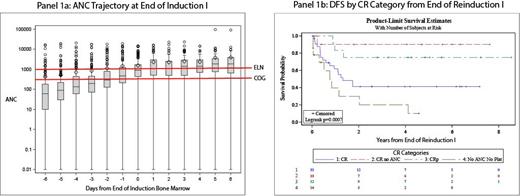Introduction:
Disease response criteria in pediatric acute myeloid leukemia (pAML) include complete remission (CR), complete remission without platelet count recovery (CRp), and complete remission with incomplete count recovery (CRi). Although clinicians use CR, CRp, and CRi as valid endpoints, the FDA only accepts CR as a valid response endpoint with the Cheson/European Leukemia Network (ELN) response criteria of absolute neutrophil count (ANC) >1,000 and platelets >100,000. Recent adult data show improved survival in patients achieving CR relative to CRp or CRi. Pediatric data from the Children's Oncology Group (COG) demonstrate similar survival regardless of achieving an ANC >500 or platelets >50,000. However, actual ANC and platelet data were not known, and COG data may not reflect outcomes of patients treated off study. Exclusion of CRp and CRi as valid efficacy endpoints limits clinical trials by potentially excluding patients who achieve remission but proceed to subsequent chemotherapy prior to meeting ELN recovery criteria. To address this data gap, we defined the ANC and platelet count trajectories in a 13-day window at end of course bone marrow (BM) after Induction I/II and Reinduction I/II of relapse therapy. We compared disease-free (DFS) and overall survival (OS) among CR categories and hypothesized that CR, CRp, and CRi after Induction I and Reinduction I would be associated with similar DFS and OS.
Methods:
Newly diagnosed pAML patients from 2011-2022 with at least one frontline chemotherapy course at one of six pediatric centers (Children's Hospital of Philadelphia, Children's Healthcare of Atlanta, Children's Hospital of Michigan, C.S. Mott Children's Hospital, Lurie Children's Hospital, and Texas Children's Hospital) underwent manual chart abstraction to capture demographic, therapy, toxicity, and BM response data: morphologic and minimal residual disease (MRD). The highest daily ANC and platelet counts were abstracted ±13 days around the last BM aspirate after Induction I/II and reinduction I/II post relapse. ELN and COG recovery criteria for ANC (>1,000 and >500, respectively) and platelet (>100,000 and >50,000, respectively) defined CR, CRp and CRi; CRi was further divided into CRnoANC and CRnoANCnoPlatelet. Standard descriptive statistics and Kaplan-Meier (KM) methods were used for analyses. Course-specific evaluations were restricted to subjects with an end of course BM documenting morphological response and ANC/platelet values on the day of course ending BM or 1 day prior.
Results:
The source population contained 486 patients with the analysis cohort restricted as described above to include 313 patients in Induction I, 290 patients in Induction II, 70 patients in Reinduction I, and 34 patients in Reinduction II. This represents 707 total courses and 8933 ANC/platelet observation days, restricted from 1166 courses (371 without morphologic response and 88 lacked ANC/platelet at course end BM). Demographic covariates included age, sex, race, ethnicity, risk group, MRD, extramedullary disease, weight category, and insurance. At Induction I, MRD differed significantly by CR category for ELN and COG criteria; risk group approached but did not reach significance; and Hispanic ethnicity differed by CR category only in COG criteria. No covariates differed significantly at Reinduction I in either ELN or COG criteria. At Induction I, CR proportion differed between ELN and COG criteria: 40.9% (95% CI 35.5-46.6%) vs 69.6% (95% CI 64.2%-74.7%). At Reinduction I, CR proportion differed between ELN and COG criteria: 18.6% (95% CI 10.3-29.7%) vs 47.1% (95% CI 35.1-59.4%). Panel 1a shows median ANC at Induction I BM is <1000 (ELN) but >500 (COG) in >75% of individuals. KM analyses showed no significant differences in CR strata in ELN or COG criteria in DFS or OS at Induction I. At Reinduction I, ELN CR strata did not differ, but COG CR strata were significantly different in DFS (p = 0.0007) and OS (p = 0.0019) with CRp and CRnoANC with higher DFS than CR or CRnoANCnoPlatelet (Panel 1b).
Conclusion:
These real-world data suggest that ELN/COG response criteria may lead to markedly different CR rates that may impact reported response rates in clinical trials. These analyses also support COG CR response criteria in de novo pAML and CR, CRp, and CRnoANC in relapsed pAML, recognizing that the modest relapsed pAML sample size requires additional data to determine optimal response criteria.
Disclosures
Elgarten:Allovir: Other: one time advisory committee. Pollard:Abbvie: Research Funding; Servier: Research Funding. Fisher:Pfizer: Research Funding; Allovir: Research Funding; Astellas: Other: Membership on Data safety monitoring board; Merck: Research Funding.


This feature is available to Subscribers Only
Sign In or Create an Account Close Modal